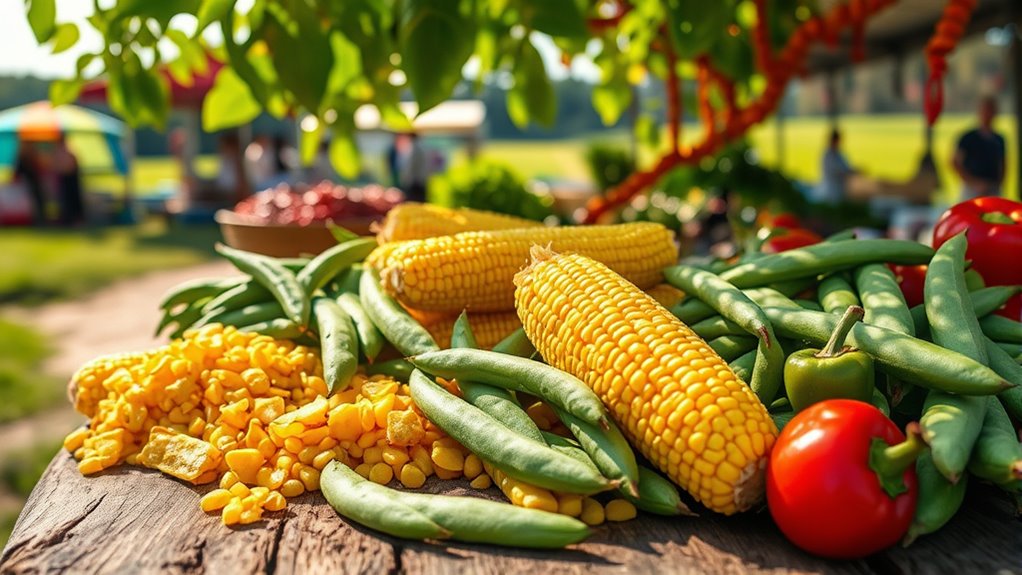To turn farmers’ market finds into Southern succotash, select fresh, in-season ingredients like sweet corn, ripe tomatoes, green beans, and peppers. Sauté or quickly cook these vibrant, local veggies to preserve their natural flavors and textures. Add herbs or a touch of honey to enhance taste, celebrating the land’s bounty. This simple, seasonal dish reflects the farm-to-table movement, and exploring more will show you how to make every bite a taste of sustainability and freshness.
Key Takeaways
- Select fresh, in-season ingredients like corn, tomatoes, green beans, and peppers directly from farmers’ markets.
- Emphasize quick cooking techniques to preserve the bright flavors and textures of seasonal produce.
- Incorporate local herbs and honey to enhance natural flavors and reflect regional tastes.
- Support sustainable practices by choosing locally sourced ingredients, reducing environmental impact.
- Turn seasonal harvests into a simple, flavorful dish that celebrates land, seasonality, and farm-to-table principles.

Harvest-to-Plate is a farm-to-table movement that emphasizes fresh, locally sourced produce delivered directly from growers to consumers. When you embrace this approach, you’re connecting with the seasons and truly appreciating the bounty that each time of year offers. This is especially true when you focus on seasonal cooking, which means using ingredients at their peak flavor and freshness. This practice helps ensure maximum nutritional value and optimal taste, as seasonal ingredients are harvested at their prime. Supporting local farmers also fosters sustainable agriculture practices that help preserve the environment. Instead of relying on out-of-season produce that’s traveled thousands of miles, you get to enjoy vibrant, flavorful vegetables straight from the farm. This not only enhances your meals but also supports local farmers and reduces your environmental footprint.
Embrace seasonal cooking to enjoy fresh, local produce and support sustainable farming practices.
When you visit a farmers’ market, you’re stepping into a world of vibrant colors, fresh aromas, and varieties you might not find in a typical grocery store. You can handpick corn, peppers, beans, and other ingredients that are ripe and in season. These ingredients form the heart of farm-to-table cooking, allowing you to craft dishes that celebrate the natural flavors of each harvest. For a simple yet delicious example, consider making Southern succotash using these fresh finds. The process begins with selecting the freshest corn, which, at the height of summer, will be sweet and tender. You can combine it with ripe tomatoes, green beans, peppers, and herbs from your local market.
By turning farmers’ market finds into a Southern succotash, you’re practicing seasonal cooking that honors the land and the time of year. You’ll want to cook the vegetables quickly to preserve their bright flavors and textures, which is a key principle in farm-to-table cuisine. This approach also encourages you to experiment with local ingredients, adding your own twist to traditional recipes. You might incorporate a splash of local honey or a dash of Southern spice to elevate the dish even more.
Cooking this way isn’t just about taste; it’s about creating a connection between you and the seasonal cycle. You’ll find that ingredients taste better when you cook with what’s fresh and in season. Plus, supporting local farmers means you’re helping sustain their livelihood and reducing the environmental impact of food transportation. As you turn your farmers’ market haul into a delightful Southern succotash, you’re doing more than preparing a meal—you’re participating in a movement that values freshness, sustainability, and the true flavors of the season. This simple, vibrant dish becomes a celebration of the farm-to-table philosophy, making every bite a reflection of the land’s bounty. Incorporating local ingredients into your cooking not only elevates the flavor but also promotes sustainability and community support.
Frequently Asked Questions
What Are the Best Seasonal Vegetables for Succotash?
When choosing seasonal vegetables for succotash, focus on highlighting local flavor and seasonal variations. During summer, opt for sweet corn, ripe tomatoes, and fresh green beans, which bring vibrant flavors. In fall, consider using butternut squash or acorn squash for added richness. These seasonal vegetables not only enhance taste but also support local farmers and celebrate the natural bounty of the season, making your succotash truly special.
How Can I Store Fresh Farmers’ Market Produce Longer?
You’d think fresh farmers’ market produce would last forever, but alas, it doesn’t. To beat the clock, use smart preservation techniques like blanching or freezing, and store your veggies in airtight storage containers. Keep them in the coldest part of your fridge, and avoid overcrowding. This way, you can enjoy your seasonal bounty longer, making every visit to the market feel like a win.
Are There Vegan or Gluten-Free Succotash Recipes?
You can easily find vegan or gluten-free succotash recipes by using plant-based swaps like coconut milk or vegan butter, and gluten-free modifications such as using corn or rice flour instead of traditional thickeners. Look for recipes that highlight fresh vegetables and omit animal products. These options guarantee your succotash remains delicious, inclusive, and suitable for various dietary needs while celebrating the vibrant flavors of fresh, seasonal produce.
What Are Common Mistakes When Preparing Succotash?
When preparing succotash, you might think more is better, but overcooking vegetables can turn vibrant colors into dull mush. Using canned ingredients might seem convenient, yet it can compromise texture and flavor. Balance is key—you want crisp-tender corn and beans that retain their brightness. Avoid rushing the process, and choose fresh or properly drained ingredients to keep your succotash lively and delicious.
How Can I Modify Succotash for Different Dietary Needs?
To modify succotash for different dietary needs, you can swap out dairy with plant-based alternatives like almond or coconut milk. For low-carb options, replace corn with zucchini or cauliflower to reduce carbs while maintaining texture. You might also add extra vegetables or protein sources to suit specific dietary preferences. These adjustments let you enjoy a customized, wholesome succotash that aligns with your nutritional goals.
Conclusion
Now, imagine the vibrant flavors waiting to burst with each bite—fresh corn, plump beans, and ripe tomatoes coming together. As you step into your kitchen, you hold the power to transform these seasonal treasures into something unforgettable. But will you follow the recipe, or let your creativity lead? The choice is yours. The journey from harvest to plate is just beginning—are you ready to uncover the delicious surprise that awaits?










